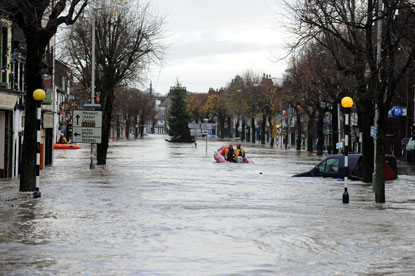By Mark Smulian | 28 October 2011
A ‘huge funding gap’ is emerging in England’s flood protection work, Public Accounts Committee chair Margaret Hodge has warned.

Speaking today as the National Audit Office issued a report, Flood risk managementin England, she said: ‘The annual cost of flood damage is £1.1bn and one in six properties in England face this threat, but they are being put at risk through reduced funding and a lack of technical expertise.’ The NAO said some 5.2 million homes were potentially at risk.
Hodge said the Department for Environment, Food and Rural Affairs spent £664m on flood defences in 2010/11 and needed to increase this by £20m each year to 2035 to cope with anticipated threats. Instead, funding had been cut by £100m this year.
Local authorities spent a further £101m from formula grant on flood works, but private sector sources contributed only £3m last year.
‘We will want to ask the department how this funding gap will be closed,’ Hodge warned.
County and unitary councils were handed responsibility for managing local flood risks after the severe inundations of 2007 exposed weaknesses caused by previously overlapping roles between agencies.
Other public bodies, including the Environment Agency, are under a duty to co-operate with them.
The NAO noted: ‘If central government funding does not increase after 2014/15, maintaining and improving current levels of flood defence will increasingly depend on significant additional funding being secured locally.’
It said the prospect of this happening was ‘unknown’ and that the local authorities it consulted ‘voiced considerable concern about securing sufficient local funds, especially in the current economic climate’.
Hodge noted it was ‘deeply worrying’ that only 30% of local authorities had told the NAO they had the skills to manage local flood risk.
Auditors also questioned the new project appraisal method used by the Environment Agency – which carries out the bulk of Defra’s flood work.
It judges proposals on the ratio of benefits to its total spending, rather than a conventional benefit-to-cost ratio.
‘Projects with lower benefit-cost ratios that have attracted local funding could displace schemes with higher benefit-cost ratios that have been unable to attract local funding,’ the auditors pointed out.
The NAO said it would be important to ensure ‘that projects enabled solely through contributions do not unjustifiably postpone more beneficial projects’.
David Rooke, acting director of flood and coastal risk management at the Environment Agency, said: ‘We will continue to make improvements to enhance the effectiveness and value for money of our services to the public at risk of flooding.’





















